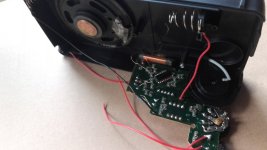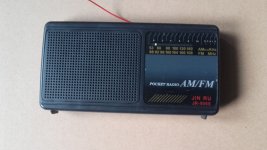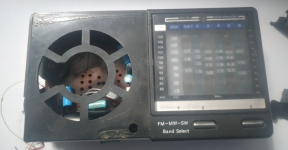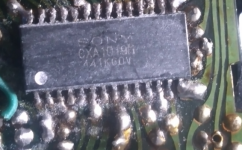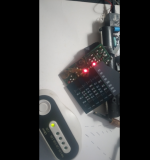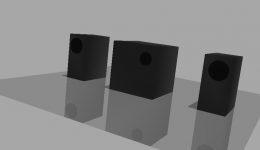Motivation
Traditional FM radio has its benefits- one of which is an unlimited supply of free music. With the advent of local radio stations that play a variery of music from the past and do't talk too much, listening to radio has become interesting again, at least for short periods of time.
A line-in will be needed as well, for an MP3 player or CD player or both.
Bluetooth is also a possibility.
Feasibility Testing
The feasibility of this project is already tested, using a transistor radio costing less than $10. The sound quality is fully acceptable, and considering that the radio uses an LM386 chip, albeit it bridged mono mode, sound quality is not expected to be an issue.
1) Satellite subwoofer home theatre system through headphone output
Sound quality - suprisingly good, though lacking bass. Distortion most probablt due to broken antenna.
2) Un-enclosed Radio Shack 6" 40-1011 woofer driver with sensitivity of 93 dB/W/m
Acceptable sound quality
3)Sony SS-G333ES speaker
Sony SS-G333ES on thevintageknob.org
These are large speakers, consisting of a 8" woofer, mid-range, and a high quality tweeter.
Sound quality was acceptable, something I could live with. Sound pressure levels at 1 metre was measured at 75dB/W/m at half volume with distortion attributable mainly to the FM reception. Connecting a long wire to the FM terminal cleared things up considerably.
All this from a transistor radio powered by 3 volts of batteries.
FM Section
The FM IC used on this little radio is a CD9088CB. Output is to one speaker although the headphone output seems to be stereo,
Traditional FM radio has its benefits- one of which is an unlimited supply of free music. With the advent of local radio stations that play a variery of music from the past and do't talk too much, listening to radio has become interesting again, at least for short periods of time.
A line-in will be needed as well, for an MP3 player or CD player or both.
Bluetooth is also a possibility.
Feasibility Testing
The feasibility of this project is already tested, using a transistor radio costing less than $10. The sound quality is fully acceptable, and considering that the radio uses an LM386 chip, albeit it bridged mono mode, sound quality is not expected to be an issue.
1) Satellite subwoofer home theatre system through headphone output
Sound quality - suprisingly good, though lacking bass. Distortion most probablt due to broken antenna.
2) Un-enclosed Radio Shack 6" 40-1011 woofer driver with sensitivity of 93 dB/W/m
Acceptable sound quality
3)Sony SS-G333ES speaker
Sony SS-G333ES on thevintageknob.org
These are large speakers, consisting of a 8" woofer, mid-range, and a high quality tweeter.
Sound quality was acceptable, something I could live with. Sound pressure levels at 1 metre was measured at 75dB/W/m at half volume with distortion attributable mainly to the FM reception. Connecting a long wire to the FM terminal cleared things up considerably.
All this from a transistor radio powered by 3 volts of batteries.
FM Section
The FM IC used on this little radio is a CD9088CB. Output is to one speaker although the headphone output seems to be stereo,
Last edited:
There are various manufactures of small 12 volt amplifiers with all the modern inputs built in for around $30. or $40. US this supplier has a fair selection of products that might fit your needs. http://www.parts Or Ebay?
Possible Applications:
1. Hobby project
2. Bedroom stereo system
3. RV/Boat/ Outdoor portable high quality audio
4. Low power system for off grid homes
1. Hobby project
2. Bedroom stereo system
3. RV/Boat/ Outdoor portable high quality audio
4. Low power system for off grid homes
On second thoughts
I think better to buy a board like this one.
Several issues. See attached images.
1. Adding another input to the amplifier IC means desoldering it from the board and adding another circuit or making a new PCB
2. The volume control and on off switch will have to be removed from the board as well.
3. The variable capacitor will have to be removed and relocated.
The search continues...One with a digital display would be nice. Anyone tried any of these?
I think better to buy a board like this one.
Several issues. See attached images.
1. Adding another input to the amplifier IC means desoldering it from the board and adding another circuit or making a new PCB
2. The volume control and on off switch will have to be removed from the board as well.
3. The variable capacitor will have to be removed and relocated.
The search continues...One with a digital display would be nice. Anyone tried any of these?
Attachments
I am not sure as to the end product or sound quality you are looking for but one sure way to find out is to try it. Best of luck on your project. Your pictured receiver would serve as a suitable preamp/tuner for a mini amp such as the Lepai 2020A + chip amp. just type it in and search for additional details.
Your pictured receiver would serve as a suitable preamp/tuner for a mini amp
This is what I was thinking, the headphone output seems to be stereo, and usually I connect headphone outputs to the input of an amplifier, It does not seem to cause any problems overpowering the amplifier input section.
I have no doubts about sound quality. The end result at present I think will be a tuner. I would like to have it built in classic form with a tuning dial.
Although the output is to one speaker, the headphone connector takes in stereo input it seems.
That would be about the only part of this radio to do with stereo though (it's probably just both channels hooked up in parallel via series resistors). The FM radio chip would appear to be a TDA7088T clone (there should be a fair bit of info on this and other TDA7000 family chips on the web, they're quite interesting in that they use an AFC circuit - also called a frequency-locked loop, FLL - to compress FM deviation), this does not include a stereo decoder, and of course the trusty LM386 is mono as well. I wonder where the AM receiver is hiding.Although the output is to one speaker, the headphone connector takes in stereo input it seems.
It seems like one could add a stereo decoder, though it's not supposed to work terribly well.
Actually making a half-decent audio amplifier is a whole of a lot easier than making a half-decent FM receiver. Without ingenious ICs, radio makers (and particularly cheap hobbyists) would be pretty much screwed. Of course you can build FM receiver circuits with one or two transistors, which in itself is cool enough, but let's not talk too much about their performance...
I thought of a way to build my receiver without taking apart any of the circuits. I could use the FM radio circuit in its entirety and add another amplifier board.
Each board would have its own power swtich. Just like component systems. Each board would have its stereo outputs.
Out puts will be connected to a source switch. Since power is low this should not cause any problems. I can then select which source powers the speakers.
Any potential issues?
Each board would have its own power swtich. Just like component systems. Each board would have its stereo outputs.
Out puts will be connected to a source switch. Since power is low this should not cause any problems. I can then select which source powers the speakers.
Any potential issues?
HI there, i m building a tuner/receiver based on - FM - SI4705 (SSOP package) and Tda7439(audio Processor), and a bluetooth receiver , controlled with a microcontroller having 2 rotary encoders
you could build some thing similar, i could share the Hex for it.
you could build some thing similar, i could share the Hex for it.
Since your from Colombo - find a person called Dilshan R Jayakody’s Web Log: Low cost TEA5767 based FM stereo radio receiver
Aditya thanks for the link. Dilshan's receiver looks nicely laid out. These circuits are a little beyond my skills at the moment.
The radio I pictured here can be repaired and re-used. I have found another small radio that runs off a single SONY radio chip. The sound quality is good, when connected to my desktop OB speakers instead of the tiny 2 inch speakers that came with it. I will have to re-attach the volume control and provide a knob for tuning but it looks like a great project.
This is the sort of thing it should look like when completed minus the many lights and knobs:
Ten... mini hi-fi systems • The Register
I could use an FM modulator to transmit songs to the radio as a sort of an alternative wireless sound system.
The question is how to obtain stereo. The chip is the SONY CXA1019
This is the sort of thing it should look like when completed minus the many lights and knobs:
Ten... mini hi-fi systems • The Register
I could use an FM modulator to transmit songs to the radio as a sort of an alternative wireless sound system.
The question is how to obtain stereo. The chip is the SONY CXA1019
Last edited:
Since your from Colombo - find a person called Dilshan R Jayakody’s Web Log: Low cost TEA5767 based FM stereo radio receiver
Link changed:
FM stereo radio receiver with RDS
Testing The Radio with FM Modulator
The radio still works in FM mode. With a properly clipped on 60 cm + wire to the antenna, reception was good. Testing with an FM modulator showed that music from a phone could be sent over to the FM radio without a big loss in clarity, although bass is less. Testing was done with earphones and that settled the fact that this was not a stereo receiver, for now that is acceptable, those small Blue Tooth speakers are not stereo either and this has the potential to sound better.
Sound quality overall was surprisingly good: the music was clear, which is a must have for any sort of music. The upper and lower ends of the spectrum leave something to be desired.
I will upload some pictures later. It looks like a go ahead.
I hope to demonstrate two concepts here: one is that is is possible to build a wireless sound system for very little money, one that sounds good and is entertaining.
The other concept is recycling, or re-purposing e-waste so it does not get into landfills. It is a concept, but there are simply not enough books or websites that promote this.
This instructables site is a nice exception, also some of the You Tube boombox to Bluetooth conversion videos.
The radio still works in FM mode. With a properly clipped on 60 cm + wire to the antenna, reception was good. Testing with an FM modulator showed that music from a phone could be sent over to the FM radio without a big loss in clarity, although bass is less. Testing was done with earphones and that settled the fact that this was not a stereo receiver, for now that is acceptable, those small Blue Tooth speakers are not stereo either and this has the potential to sound better.
Sound quality overall was surprisingly good: the music was clear, which is a must have for any sort of music. The upper and lower ends of the spectrum leave something to be desired.
I will upload some pictures later. It looks like a go ahead.
I hope to demonstrate two concepts here: one is that is is possible to build a wireless sound system for very little money, one that sounds good and is entertaining.
The other concept is recycling, or re-purposing e-waste so it does not get into landfills. It is a concept, but there are simply not enough books or websites that promote this.
This instructables site is a nice exception, also some of the You Tube boombox to Bluetooth conversion videos.
Last edited:
Pictures
Detailled pictures of the radio and the board. I would say it is beyond restoration.
The soldering on the chip does not look that great come to think of it.
Testing with the FM modulator shown revealed clear sound but bandwidth limited. This is the real problem with this FM modulator, which needs a new audio cable (one channel not working). Testing the FM modulator on a 1980s portable stereo - National RX 5030 - revealed the awful state of the speakers on that thing, I think small speakers should be banned simply. Also the tweeters were not working.
Detailled pictures of the radio and the board. I would say it is beyond restoration.
The soldering on the chip does not look that great come to think of it.
Testing with the FM modulator shown revealed clear sound but bandwidth limited. This is the real problem with this FM modulator, which needs a new audio cable (one channel not working). Testing the FM modulator on a 1980s portable stereo - National RX 5030 - revealed the awful state of the speakers on that thing, I think small speakers should be banned simply. Also the tweeters were not working.
Pictures of the radio and 3D graphic of planned unit
Missed the pictures in previous post.
Missed the pictures in previous post.
Attachments
Removing the board, it appears that it can be mounted on a vertical support, there are points where the board can be secured in place using a nut and bolt assembly. The volume knob will stay, operated from the side of the unit, and the FM/AM/SW switch and the tuning knob will be operated from the front.
The click buttons for the AM/FM/SW selection were more of a problem, but these can be accessed with some sort of conducting button from the front.
It is an interesting exercise, designing an enclosure and an interface for the radio board, makes one appreciate the commercial mini stereo designs that are out there, and the vintage ones as well.
Vintage audio system collection - 1001 Hi-Fi | The Stereo Museum
I am assuming the sound from this system will be better than a Bluetooth speaker, however it will not be in stereo, just dual mono. The other problem is how to connect two 4 Ohm speakers to an output that was meant for a 3.2 Ohm speaker.
The click buttons for the AM/FM/SW selection were more of a problem, but these can be accessed with some sort of conducting button from the front.
It is an interesting exercise, designing an enclosure and an interface for the radio board, makes one appreciate the commercial mini stereo designs that are out there, and the vintage ones as well.
Vintage audio system collection - 1001 Hi-Fi | The Stereo Museum
I am assuming the sound from this system will be better than a Bluetooth speaker, however it will not be in stereo, just dual mono. The other problem is how to connect two 4 Ohm speakers to an output that was meant for a 3.2 Ohm speaker.
Last edited:
Further Testing
There was a problem traced to the input mini rca connector wire, which I find the pinout is like this:
3 pin stereo plug connector @ Pinouts.ru
I cut away the wire and resoldered in to the board with some difficulty. Testing was performed then with an output from the laptop playing ogg and Wav and FLAC format music to the following receivers:
Transistor radio electronics + headphones : Acceptable
Transistor radio electronics + PC speaker drivers : Acceptable and loud enough
Transistor radio electronics + desktop open baffle : good, and bass can be turned up but distorted with the speakers I had
Transistor radio electronics + SONY ES Receiver : signal strength is high, 5 bars, but sound is very distorted , reception may be very poor but the five bars does not explain it.
Testing has proven that it is worth proceeding with this project, goal of a system that sounds as good as a Bluetooth speaker (and I have two branded speakers : a SONY XBS and a BOSE Soundcolor (Black in color though). Both have good bass, reasonable clarity but no twinkling high end and no stereo or at least two speakers.
There was a problem traced to the input mini rca connector wire, which I find the pinout is like this:
3 pin stereo plug connector @ Pinouts.ru
I cut away the wire and resoldered in to the board with some difficulty. Testing was performed then with an output from the laptop playing ogg and Wav and FLAC format music to the following receivers:
Transistor radio electronics + headphones : Acceptable
Transistor radio electronics + PC speaker drivers : Acceptable and loud enough
Transistor radio electronics + desktop open baffle : good, and bass can be turned up but distorted with the speakers I had
Transistor radio electronics + SONY ES Receiver : signal strength is high, 5 bars, but sound is very distorted , reception may be very poor but the five bars does not explain it.
Testing has proven that it is worth proceeding with this project, goal of a system that sounds as good as a Bluetooth speaker (and I have two branded speakers : a SONY XBS and a BOSE Soundcolor (Black in color though). Both have good bass, reasonable clarity but no twinkling high end and no stereo or at least two speakers.
- Home
- Amplifiers
- Chip Amps
- Ultra low-cost receiver (Tuner+Amp) project

